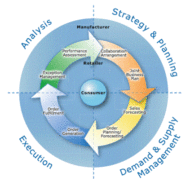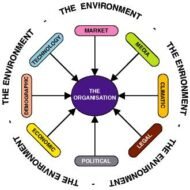Posted by Managementguru in Business Management, Marketing
on Mar 3rd, 2014 | 0 comments

Product Forecasting – An Analogy What is Product Forecasting: It is the science of predicting the degree of success a new product will enjoy in the marketplace. Forecasting is said to be the first and foremost step in the planning process. One of the requirements for effective long-term planning by managers is to assess the changes in technology and environmental conditions that could affect the firm. This is termed as environmental scanning which facilitates the firm to benchmark its performance as against the top industry standards. Technological forecasting involves anticipating development of new products and processes and the time taken for such kind of innovations to be accepted and absorbed in the market. External Environmental Scanning: Environmental forecasts focus on factors such as population growth, availability of resources, social and political trends that may affect the firm’s future. Business firms become more informative on, The percentage of market share for existing products of the firm Future demand for its product range Decline in sales proportions Consumer feedback about product performance Customer satisfaction Sales team performance level Pitfalls in marketing strategies Need for new product development Unidentified customer needs and so on All predictive activity is subject to error, but technological and environmental forecasting is particularly different because they often involve assessing ideas and relationship that do not exist at the time the analysis is being performed. These forecasts are best suited for predicting performance a year or two in the future. Plan of Future Course of Action: Based on forecasting, the firm decides the future course of action. Sales forecasts help the firm to decide on the volume of production for the next few months and aid in aggregate capacity planning. Labor productivity is a crucial factor in determining the success of a business environment, especially a production environment. Manpower planning is purely based on production forecasts where in, the labor hour productivity is also taken into consideration. Forecasting Techniques: In the absence of empirical data, the forecasts must be based on expert opinions. Techniques like Delphi method can be used for this purpose. A group of experts is asked to assess a particular situation, presented with the judgments of others in the group, and then asked to reevaluate their individual positions based on what they have heard. The process continues until a consensus is arrived or until it is apparent that there will be no consensus. This helps the firm to consolidate its position with respect to specific problem situations. The Delphi method has been successfully used to forecast the nature and timing of technological change. Techniques like Delphi and Brain storming also help in the process of identification of bottlenecks, the current business trend, the firm’s future prospects, range of estimates for the desired breakthroughs etc. Although the pattern of a business cycle or a product cycle for the most part, follows a fairly predictable pattern, the firm cannot overlook probabilities, upon which the firm has to capitalize on. The firm has to become alert and employ some innovations at that point of time, when the market becomes saturated. Or else, the rate of growth declines and the firm has to decide whether to continue with the operations which calls for additional investment or close down the...

Posted by Managementguru in Business Management, Principles of Management
on Feb 26th, 2014 | 0 comments

Factors of External Environment of Business What do you mean by Business Environment: The sum total of all things external to firms and industries that affect the functioning of the organization is called Business Environment. Elements of Business Environment 1. ECONOMIC 2. SOCIAL 3. CULTURAL 4. POLITICAL 5. LEGAL 6. TECHNOLOGICAL 7. DEMOGRAPHIC 8. GEOGRAPHICAL 9. ECOLOGICAL 1. Economic Environment This refers to all economic factors that influence and affects the very survival of an organization. Can be classified into · Economic factors affecting demand · Competitive forces Economic factors affecting demand The existence of an organization depends on the demand for its products or services. The customers’ ability to buy and willingness to pay determine the demand factor. The buying power is determined again by · Employment · Income taxes · Saving and · Prices The money acquired by an individual through employment is utilized for paying taxes which is the first priority and then comes saving or spending. In developing countries like India, much importance is attached to the habit of saving in the form of insurance policies or mutual fund deposits or investment on immovable assets. This makes the economy strong and stable even during times of recession, whereas we witness the economy of some developed countries entirely shaken when there is an economic depression. Sub Prime Lending Sub prime lending may prove to be disastrous for a growing or grown nation when the money is lent by the banks to third parties without proper securities or collaterals. While the initiative is intended to increase the growth rate or GDP, the end result may not live up to the expectations when the money is parted to individuals or firms with poor financial credentials. Disposable Income Disposable income also decreases when the tax rate increases and his/her ability to buy is reduced. Equally important is the willingness to by because the fact that an individual has the ability does not mean that he or she will buy. Willingness is affected by the preferences for products and the expectation about future factors like the price fluctuation, increase in one’s own income, general economic trend and so on. Competitive forces Firms have to first survive in order to succeed in the market. To accomplish this they exert competitive force on each other through one or the other following methods. · Price cutting · Promotion-advertising, personal selling · Design, feature and packing · Number and type of customer services offered give a cutting edge to firms competing in the race. 2. Social and Cultural Environment The social environment depends upon the · The class structure · Mobility · Nature of the social organization and · Development of social institutions People always have the unending desire to move from one occupational category to another and this is the main reason for high job turn over in IT industries for various reasons like pay, promotions, job satisfaction etc., This is the same reason which can be attributed to the failure of many good projects that go underway due to lack of continuation of the same initiative with which it was started. The above said process is more prevalent in urban societies than rural where scope of mobility is much the less among farmers, artisans and those engaged in traditional crafts and cottage industries. 3. Political Environment A smart manager has to be on tenter hooks to gauge the trends in political scenario that directly or indirectly affect the functioning of the firm. The political weather is highly unpredictable and may be classified into · Long-term changes · Quick changes · Cyclical changes · Regional changes Now-a-days we see that the economic depression in...




